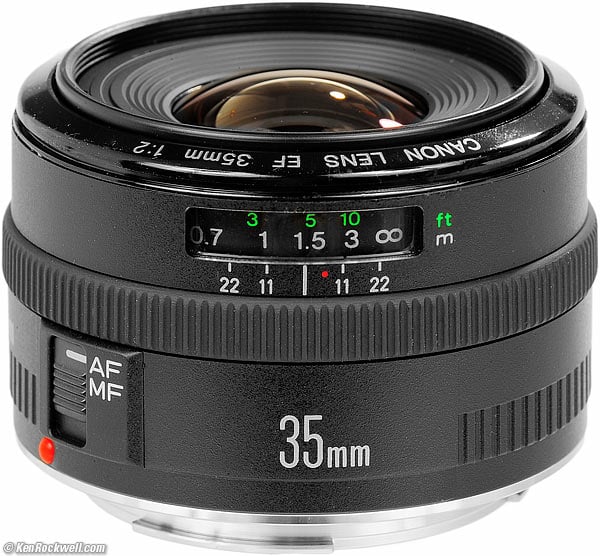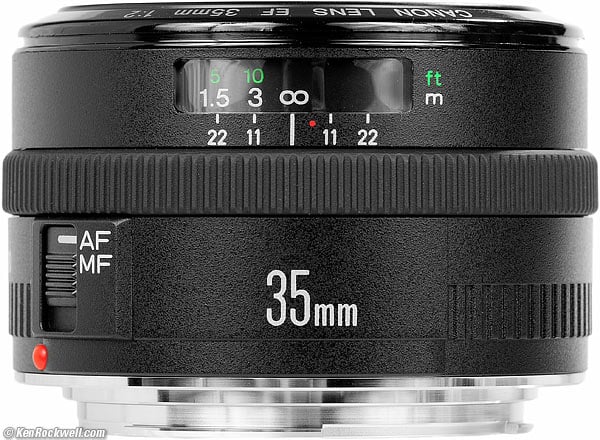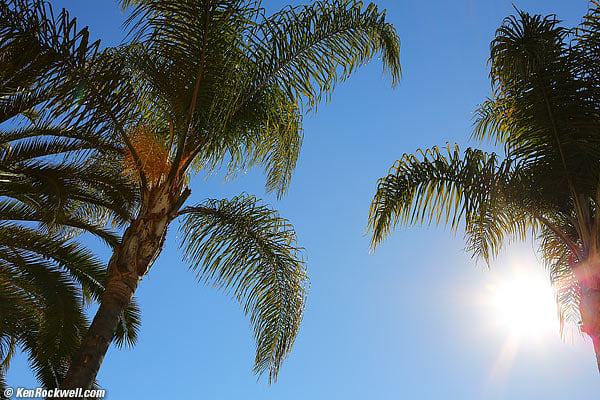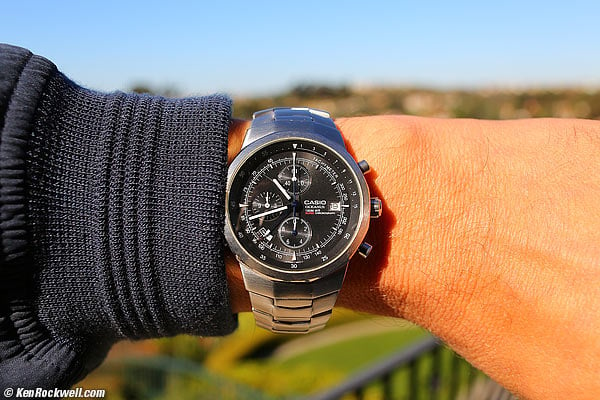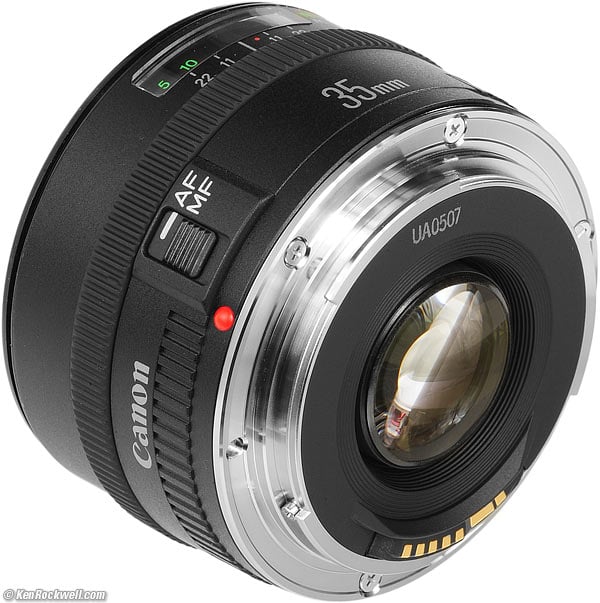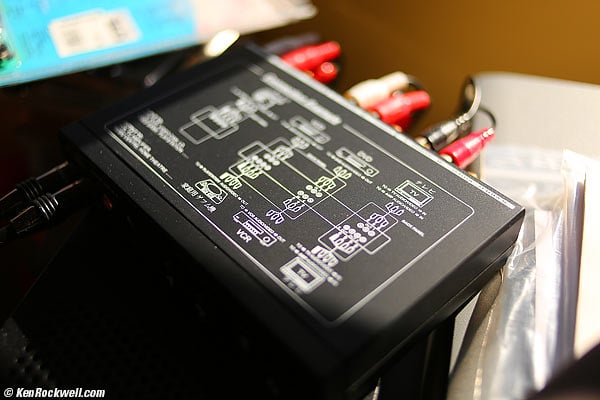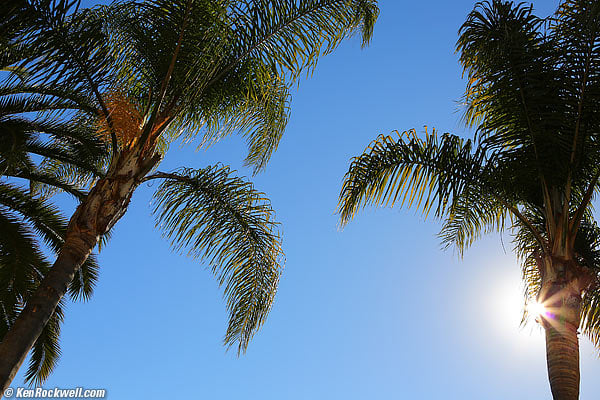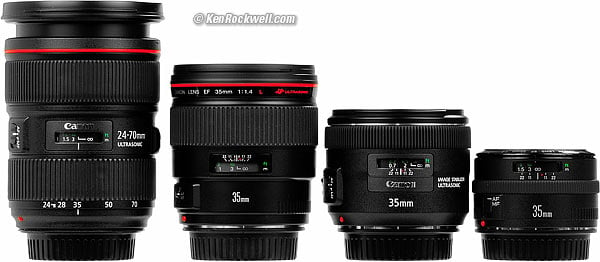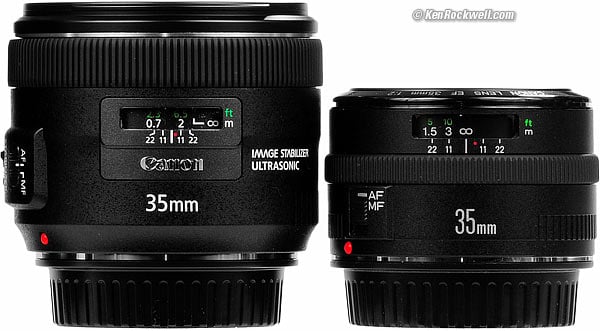Home Donate New Search Gallery Reviews How-To Books Links Workshops About Contact
Canon 35mm f/2
EF (1990-today)
© 2012 KenRockwell.com. All rights reserved.
Intro Specs Performance Compared Recommendations More
Canon EF 35mm f/2 (works on all Canon autofocus SLRs: digital and 35mm, 52mm filters, 6.8 oz./192g, 0.8'/0.25m close focus, about $310 new or $250 used). enlarge. My biggest source of support is when you use any of these links, especially this link directly to it at Adorama, directly to it at Amazon, or used at eBay (see How to Win at eBay), when you get anything, regardless of the country in which you live. Thanks! Ken.
January 2013 Canon Reviews Canon Lenses All Reviews
NEW: 35mm f/2 IS (2012-)
35mm f/1.4 L (1998-)
Sample Image File
Pizza Mania, Legoland, 22 December 2012. (5D Mark III at ISO 100, f/10 at 1/250, 6 sharpening, +4 saturation.) Camera-original © 22MP image.
Introduction top
Intro Specs Performance Compared Recommendations More
|
Adorama pays top dollar for your used gear. I use these stores. I can't vouch for ads below.
|
This Canon 35mm f/2 lens has been a staple of Canon's catalog since its introduction in 1990.
It has always been popular because of its extremely high image quality and its super-fast autofocus. It's only shortcomings are a noisy autofocus motor and the need to slide a switch to get between auto and manual focus.
The only reasons to pay more for the newest 35mm f/2 IS (2012-) is to get instant manual-focus override and Image Stabilization, neither of which are worth paying three times as much to me.
The professional 35mm f/1.4 L (1998-) is built much more solidly and also offers instant manual-focus override, as well as a stop more speed. The higher speed is mostly of interest to serious photographers shooting 35mm film; with digital's clean super-high ISOs, lens speed is no longer that important. If you want soft backgrounds, use a longer lens rather than a faster wide lens.
Specifications top
Intro Specs Performance Compared Recommendations More
Name
Canon calls this the CANON LENS EF 35mm f/2.
EF means "electronic focus," meaning that there is an autofocus motor in the lens itself. All Canon lenses since 1987 have been EF.
Optics top
7 elements in 5 groups.
Unit focus.
Multicoated, branded as "Optimized Super Spectra Coating."
Focal Length top
35mm.
On 1.3x Canon cameras it will see angles-of-view similar to what a 45mm lens would see on a 35mm camera.
On 1.6x Canon cameras it will see angles-of-view similar to what a 55mm lens would see on a 35mm camera, which is actually a very useful zoom range.
Angle of View (on 35mm and full-frame cameras)
63º diagonal.
38º vertical.
54º horizontal.
Close Focus top
0.8 feet (0.25m), specified, from the image plane.
Maximum Reproduction Ratio top
1:4.3 (0.23x), specified.
Diaphragm top
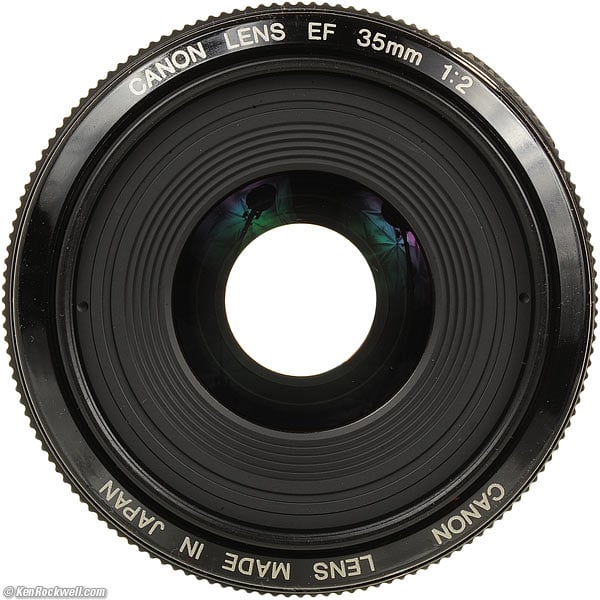
Canon 35mm f/2 at f/2, EF diaphragm not visible.
5 blades.
Stops down to f/22.
Hard Infinity Focus Stop? top
Yes, but it's a tiny tad just beyond infinity, so it's best to let the AF system focus for you at infinity.
Focus Scale top
Yes.
Depth-of-Field Scale top
Yes.
Infra-Red Focus Index top
Yes, red dot.
Most likely for 800 nm.
Filter Thread top
52mm.
Plastic.
Does not rotate.
Size top
Canon specifies 2.7" (67.4mm) diameter by 1.7 " (42.5mm) long.
Weight top
6.760 oz. (191.6g), measured in 2013.
Canon still specifies 7.4 oz. (210 g), the same numbers they've been using since they first introduced this lens decades ago.
Caps top
52mm E-52 front, included.
Standard EOS cap rear, included.
Hood top
Optional EW-65 II plastic snap-on, $19 extra.
I wouldn't buy it; I don't use hoods.
Case top
Optional LP-1011 sack.
Included top
Lens and caps; that's it.
Introduced top
1990.
Quality top
Made in Japan.
Price, USA top
2013 January: $310 new or $250 used.
2005: $225 new.
1995: $300 new.
1994: $220 new.
1992: $208 new.
1991: $213 new.
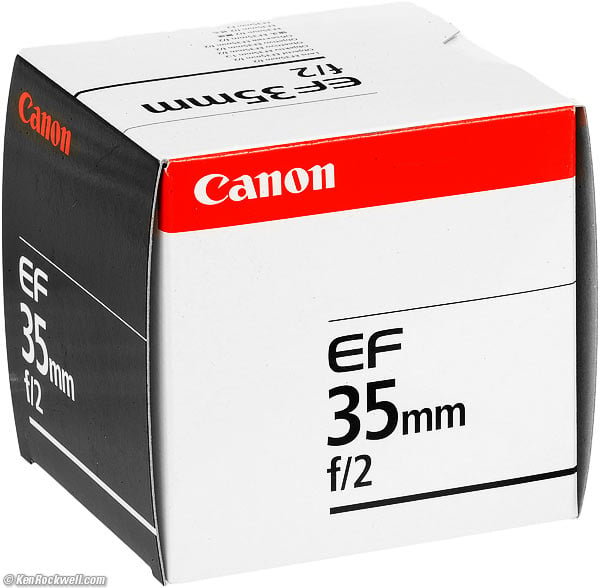
Box, Canon 35mm f/2.
Performance top
Intro Specs Performance Compared Recommendations More
Overall Autofocus Bokeh Breathing Color Coma
Distortion Ergonomics Falloff Filters Flare & Ghosts
Lateral Color Fringes Macro Mechanics
Sharpness Spherochromatism Sunstars
Canon EF 35mm f/2. enlarge.
Overall performance top
The Canon 35mm f/2 is optically superb and handles very well — except that you need to slide a switch to get to and from manual focus.
Its only other vice is that the autofocus motor, while very fast, sounds like a kid's toy.
This lens' optics are as good as the newest 35mm f/2 IS, with a little less distortion, fewer ghosts and better sunstars.
This 35mm f/2 lens offers superb performance, and it's smaller and lighter than the newer 35mm f/2 IS, as well as only about one-third the price.
Autofocus performance top
Autofocus is fast, but the little Arc-Form Drive motor buzzes as it focuses. It is not an ultrasonic motor.
Auto/Manual Switching
You have to move the AF-MF switch anytime you want to select one or the other. If you move the focus ring while set to AF, it turns, but nothing happens.
AF Speed
AF is fast!, as Canons always are.
AF Accuracy and Consistency
I saw no autofocus error on my Canon 5D Mk III.
Especially at f/2, every shot is dead-nuts on.
Yes! Perfection!
Manual Focus
Manual focus is easy; just grab the ring, but you do have to slide the switch to "MF" first.
Bokeh performance top
Bokeh, the quality of out-of-focus areas as opposed to the degree of defocus, ranges from good to poor depending on your focused distance. Oddly, it's the same as the newest 35mm f/2 IS!
Ryan at the Sports Cafe. (Canon 5D Mark III, Canon EF 35mm f/2, Auto ISO 250, f/2 at 1/125, 6 sharpening, Athentech Perfectly Clear plug-in in Photoshop CS6.) bigger.
It's good at close distances at f/2 where you need it most, but becomes quite nasty when focused at about 3 meters (10 feet) or more with backgrounds at infinity at f/2.
Here are crops from the center of full-frame 22MP 5D Mk III images at 25%. In other words, each crop shows about one-fifth of the image horizontally, and about one-third vertically. If each is about 3" (7.5 cm) on your screen, the complete images would print at about 10 x 15" (25 x 38 cm) at this same magnification. The focus is on a reference phase lattice at 1 meter (3 feet) with synthetic reference vegetation at 15 meters (50 feet):
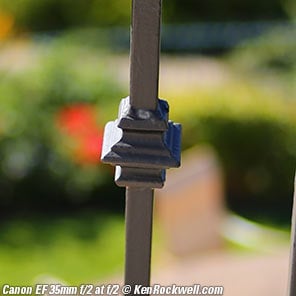 |
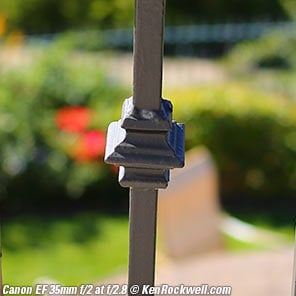 |
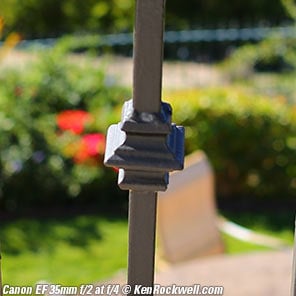 |
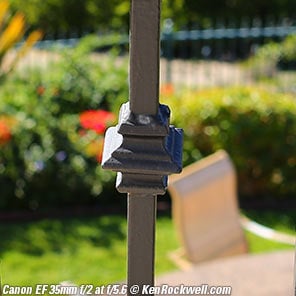 |
These look pretty good, since I'm only 1 meter away.
Here's the bad news. This is a crop at 100% from the center of a full-frame 22MP 5D Mk III image of the background at f/2 at infinity, when focused at 3 meters (10 feet):
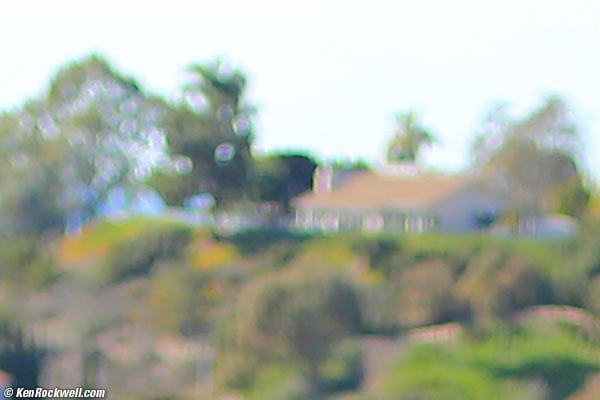
Crop from 22MP full-frame image at 100% at f/2, focus at 3 meters, background seen here at infinity
Focus Breathing performance top
Focus breathing (the image changing size as focused) is mostly of interest to cinematographers who don't want the image changing size ("breathing") as the lens is focused among different subjects.
The image from the Canon 35mm f/2 IS gets larger as focused more closely.
Color Rendition performance top
The color balance of this 35mm f/2 seems the same as my other Canon EF lenses.
Coma performance top
Coma, or saggital coma flare, is when points of light in the corners turn into batwing-shaped blobs. This is often a problem with fast normal or wide lenses.
This conventional spherical Canon 35 has a little coma at f/2. It gets better at f/2.8, and is gone by f/5.6.
The newest 35mm f/2 IS (2012-) is only a little better.
Distortion performance top
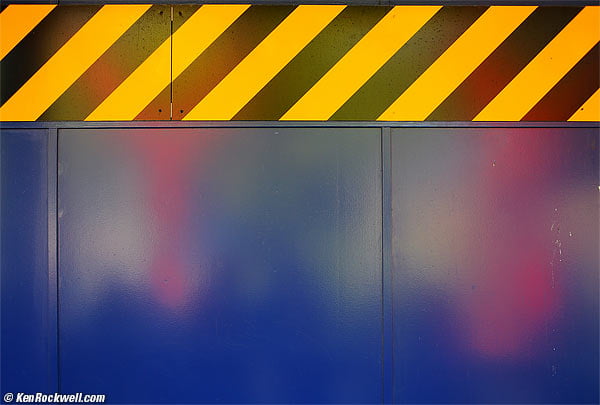
Wall, 22 December 2012. (5D Mark III at ISO 100, f/3.2 at 1/50.)
The Canon 35mm f/2 has low to moderate barrel distortion, a tad less than the 35mm f/2 IS or 35mm f/1.4 L. If you're shooting brick walls, use the Canon 50mm f/2.5 Macro, or accept that this lens will make the central part appear to bulge out a bit, with the sides staying relatively flat. Shoot anything other than a grid, like the lines above for example, and any distortion is invisible.
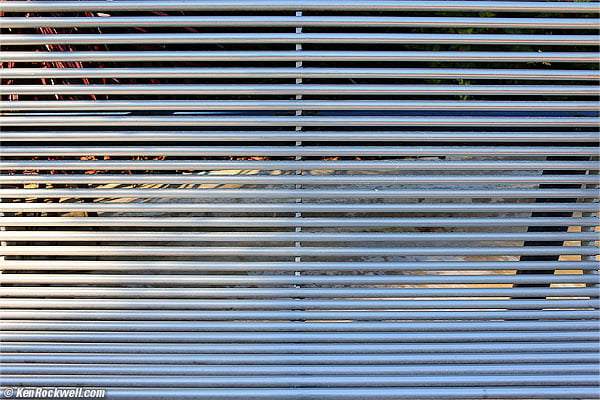
Seat, 22 December 2012. (5D Mark III at ISO 100, f/5.6 at 1/125.)
Use these values in Photoshop's Lens Distortion tool to remove the distortion for more critical use, however a tiny bit of waviness remains:
| Factor on Full-Frame or 35mm | 35/2 (this lens) |
||
Infinity |
+1.3 |
+1.4 |
+1.3 |
3m (10') |
+1.1 |
+1.2 |
+1.0 |
© 2013 KenRockwell.com. All rights reserved.
Ergonomics performance top
Canon EF 35mm f/2. enlarge.
Ergonomics are just about perfect, except needing to slide a switch to swap between auto and manual focus.
The AF - MF switch falls right under your thumb.
In manual focus, just a fingertip is all that's needed for focusing.
Falloff (darkened corners) performance top
Falloff is barely visible at f/2, and invisible at all other apertures using a lens profile with my Canon 5D Mark III, 6D or 1D X.
On film or without a profile it's visible at f/2, mostly gone by f/2.8, and completely gone by f/4.
I've greatly exaggerated this by shooting a flat gray target and presenting it against a gray background.
Canon 35mm f/2 falloff on full-frame 5D Mk III peripheral illumination control active:
© 2012 KenRockwell.com. All rights reserved.
5D Mk III peripheral illumination control disabled (same results on film):
© 2012 KenRockwell.com. All rights reserved.
|
Filters, Use with performance top
The plastic 52mm filter threads are big enough that even thick stacked filters won't cause any vignetting on full-frame (or any other format).
Go ahead, use any big, fat thick filter, and you'll still be able to add a second one, too!
It's easy to cross-thread the plastic threads, be careful.
Flare and Ghosts performance top
At f/10, direct view of mid-day tropical sun. bigger.
Flare and ghosts are extremely well controlled — even better controlled than in the newest 35mm f/2 IS. You'll never see any flare or ghosts unless you put the full disc of the sun in your image and deliberately put something dark elsewhere to show anything, as I did here. Even if you do this, there is only the slightest hint of a tiny green pip.
Lateral Color Fringes performance top
Better than most Canon lenses, there no visible lateral color fringes at 22MP full-frame, even if shot without a lens profile. This is a tiny bit better than the 35mm f/1.4 L, if you're shooting without a profile as we always do on 35mm film.
Macro performance top
At close-focus distance on full-frame at f/8, Canon 35 f/2.
The images would be even tighter on smaller-format cameras (see crop factor).
It's super-sharp; here's a crop from a 22MP full-frame image at 100%:
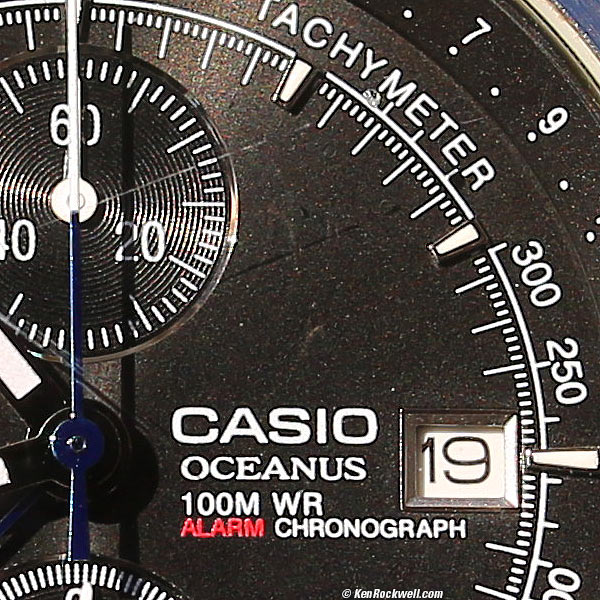
Crop from above image at 100%, shot at f/8 at ISO 100 on a Canon 5D Mk III. If this is 6" (15cm) wide on your screen, the full image would print at 39 x 58" (1 x 1.5 meters)!
Mechanics performance top
Rear, Canon EF 35mm f/2. enlarge.
The Canon 35mm f/2 is made to typical consumer standards, same as the new 35mm f/2 IS: all plastic, except for the glass and the mount.
Filter Threads
Plastic.
Hood Mount
Plastic.
Identity Ring
Plastic.
Focus Ring
Rubber-covered.
Barrel
Plastic.
Internals
Unseen.
Moisture seal at mount
No.
Mount
Chromed metal.
Markings
Paint.
Serial Number
Engraved into the bottom of the black plastic lens barrel and filled with white paint.
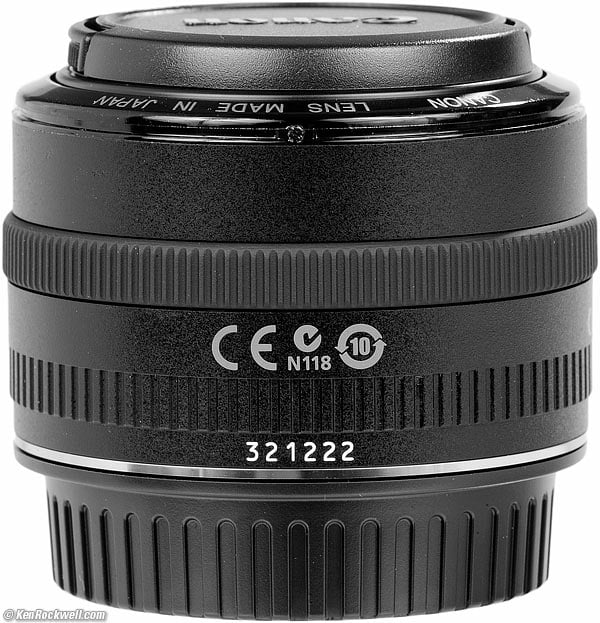
Bottom, Canon EF 35mm f/2.
Date Code
Stamped in white ink on rear light baffle.
This sample is stamped UA0507, meaning made in May 2012 (see Canon Date Codes).
Noises When Shaken
Mild clunking.
Made in
Japan.
Sharpness performance top
Image sharpness depends more on you than your lens, and lens sharpness doesn't mean much to good photographers. It's the least skilled hobbyists who waste the most time blaming fuzzy pictures on their lenses, while real shooters know that few photos ever use all the sharpness of which their lenses are capable due to subject motion and the fact that real subjects are rarely perfectly flat, like this pizza place sign:
Pizza Mania, 22 December 2012. (5D Mark III at ISO 100, f/10 at 1/250, 6 sharpening, +4 saturation.) Camera-original © 22MP image.
This said, the Canon 35mm f/2 is among the sharpest wide lenses I've tested, just like the 35mm f/1.4 L (1998-) and new 35mm f/2 IS (2012-). The only differences between these and the 24-70/2.8 L II is if you're looking in the far corners on full-frame, in which case, this original 35/2 is slightly less sharp than the others wide-open, but the same stopped down, and the same throughout 95% of the rest of the image that matters.
This 35/2 is extraordinarily sharp and contrasty, even at f/2. Throughout 95% of the image, there is no difference between f/2 and stopped down, as seen on a 22MP 5D Mark III at the test range at infinity. As one stops down to f/8, the last few percent of the corners of the image sharpen up, too — and when was the last time anyone even had anything in perfect focus in the corners so it would matter anyway?
So long as you're in focus, sharpness doesn't vary much from perfection, except by f/11, where diffraction softens the image.
Throughout most of the image (except the last millimeter in the corners), this lens is just as sharp at f/2 as it is stopped down!
Hey, sorry to spare you endless boring charts, but with a lens this good, there's nothing to show other than sharp pictures under all conditions.
The biggest detriment to sharpness will be a lack of proper vision and technique, never this lens. I bought mine directly from Adorama. I can't vouch for anything if you buy from a local store or chain where you never really know who's opened and played with your lens before you buy it. I never buy retail; too many risks, so why pay more?

Canon's specified MTF curve, 35/2.
Spherochromatism performance top
Spherochromatism, misnamed "color bokeh" by laymen, is when out-of-focus highlights take on color fringes at full aperture. This is common in fast lenses.
The Canon 35/2 has the usual spherochromatism at f/2:
Full-frame image at f/2.

Crop from center of above 22MP Canon 5D Mk III image at 100%. If this is 6" (15cm) wide on your screen, the full image would print at 39 x 58" (1 x 1.5 meters) at this magnification!
Background highlights may have green fringes, and foreground highlights may have magenta fringes at f/2.
This is normal, and helps bokeh, smoothing out foliage (green) backgrounds even further.
If you're in perfect focus, there are no fringes.
Spherochromatism is a completely different aberration from lateral color fringes.
Sunstars performance top
At f/10, mid-day tropical sun. bigger.
With its 5-bladed diaphragm, this Canon 35mm f/2 makes relatively soft 10-pointed sunstars on brilliant points of light.
This doesn't seem like much, but it's much better than the goofy 8-pointed sunstars of the new 35mm f/2 IS (2012-) and 35mm f/1.4 L (1998-).
Compared top
Intro Specs Performance Compared Recommendations More
This 35/2 is smaller, lighter and less expensive than any other fixed Canon 35mm autofocus lens. It's also just as sharp, with less flare, very slightly less distortion and better sunstars.
The reason to get the new 35mm f/2 IS (2012-) instead for triple the price is to get Image Stabilization, which isn't very important in a fast, wide lens, and instant manual-focus override. The newer IS lens isn't built any tougher.
The reason to get the professional 35mm f/1.4 L (1998-) is because it's built pro-tough out of a lot of metal, and it's a stop faster for very low-light (more needed for real 35mm photography than with the ultra high ISOs of digital), and it also has instant manual-focus override.
The pictures from this least expensive lens will be the same as from either of the more expensive lenses.
Personally I prefer the most expensive new 24-70/2.8 L II over any of these fixed lenses mostly because of its 18-pointed sunstars, and because it's a hair sharper in the lab at infinity in the far corners wide open.
See also Compared to other Canon 35mm lenses.
Canon 24-70/2.8 L II, 35mm f/1.4 L, 35mm f/2 IS and 35mm f/2. enlarge.
Canon 35mm f/1.4 L, 35mm f/2 IS and 35mm f/2. enlarge.
Canon 35mm f/2 IS and 35mm f/2. enlarge.
Recommendations top
Intro Specs Performance Compared Recommendations More
There's really no reason to pay more for the newest 35mm f/2 IS (2012-) or professional 35mm f/1.4 L (1998-), unless you dislike having to slide a switch to get manual focus, or need tougher build and faster speed (35/1.4L) or Image Stabilization (35/2 IS).
Otherwise, there's a reason this superb 35/2 sells used today for almost as much as it sells for new: because it's a great lens and is always in demand.
If you've found all the time, effort and expense I put into researching and sharing all this, my biggest source of support is when you use any of these links, especially this link directly to it at Adorama, directly to it at Amazon, or used at eBay (see How to Win at eBay), when you get anything, regardless of the country in which you live.
Thanks!
Ken.
More Information top
Intro Specs Performance Compared Recommendations More
Help me help you top
I support my growing family through this website, as crazy as it might seem.
The biggest help is when you use any of these links when you get anything, regardless of the country in which you live. It costs you nothing, and is this site's, and thus my family's, biggest source of support. These places have the best prices and service, which is why I've used them since before this website existed. I recommend them all personally.
If you find this page as helpful as a book you might have had to buy or a workshop you may have had to take, feel free to help me continue helping everyone.
If you've gotten your gear through one of my links or helped otherwise, you're family. It's great people like you who allow me to keep adding to this site full-time. Thanks!
If you haven't helped yet, please do, and consider helping me with a gift of $5.00.
As this page is copyrighted and formally registered, it is unlawful to make copies, especially in the form of printouts for personal use. If you wish to make a printout for personal use, you are granted one-time permission only if you PayPal me $5.00 per printout or part thereof. Thank you!
Thanks for reading!
Mr. & Mrs. Ken Rockwell, Ryan and Katie.
Home Donate New Search Gallery Reviews How-To Books Links Workshops About Contact
